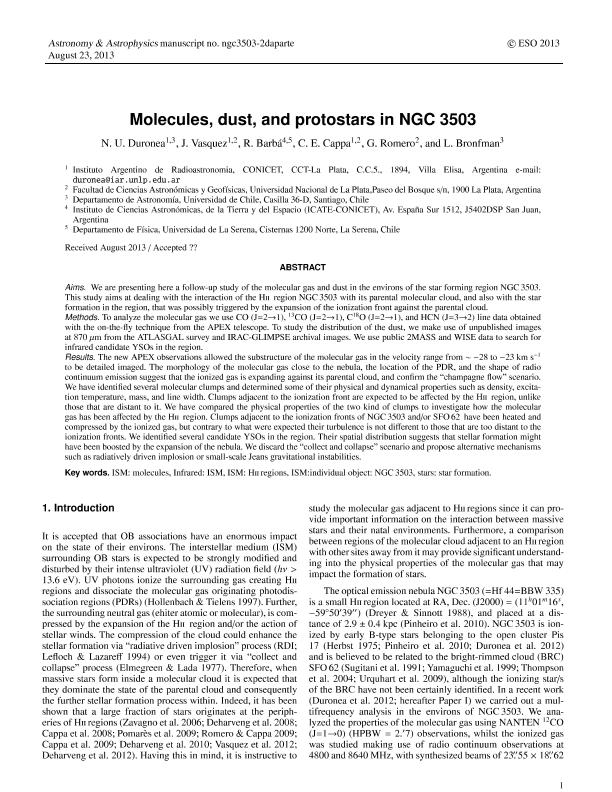Mostrar el registro sencillo del ítem
dc.contributor.author
Duronea, Nicolas Urbano

dc.contributor.author
Vasquez, Javier

dc.contributor.author
Barba, Rodolfo Hector

dc.contributor.author
Romero, G.

dc.contributor.author
Cappa, Cristina Elisabeth

dc.contributor.author
Bronfman, L.
dc.date.available
2017-09-04T18:15:41Z
dc.date.issued
2014-05
dc.identifier.citation
Duronea, Nicolas Urbano; Vasquez, Javier; Barba, Rodolfo Hector; Romero, G.; Cappa, Cristina Elisabeth; et al.; Molecules, dust, and protostars in NGC 3503; EDP Sciences; Astronomy and Astrophysics; 565; 30; 5-2014; 30-48
dc.identifier.issn
0004-6361
dc.identifier.uri
http://hdl.handle.net/11336/23559
dc.description.abstract
Aims: We present here a follow-up study of the molecular gas and dust in the environs of the star forming region NGC 3503. This study aims at dealing with the interaction of the Hii region NGC 3503 with its parental molecular cloud, and also with the star formation in the region, that was possibly triggered by the expansion of the ionization front against the parental cloud. Methods: To analyze the molecular gas we use CO(J = 2 → 1), 13CO(J = 2 → 1), C18O(J = 2 → 1), and HCN(J = 3 → 2) line data obtained with the on-the-fly technique from the APEX telescope. To study the distribution of the dust, we make use of unpublished images at 870 μm from the ATLASGAL survey and IRAC-GLIMPSE archival images. We use public 2MASS and WISE data to search for infrared candidate young stellar objects (YSOs) in the region. Results: The new APEX observations allowed the substructure of the molecular gas in the velocity range from ~-28 km s-1 to -23 km s-1 to be imaged in detail. The morphology of the molecular gas close to the nebula, the location of the PDR, and the shape of radio continuum emission suggest that the ionized gas is expanding against its parental cloud, and confirm the champagne flow scenario. We have identified several molecular clumps and determined some of their physical and dynamical properties such as density, excitation temperature, mass, and line width. Clumps adjacent to the ionization front are expected to be affected by the Hii region, unlike those that are distant from it. We have compared the physical properties of the two kinds of clumps to investigate how the molecular gas has been affected by the Hii region. Clumps adjacent to the ionization fronts of NGC 3503 and/or the bright rimmed cloud SFO 62 have been heated and compressed by the ionized gas, but their line width is not different from those that are too distant from the ionization fronts. We identified several candidate YSOs in the region. Their spatial distribution suggests that stellar formation might have been boosted by the expansion of the nebula. We discard the collect-and-collapse scenario and propose alternative mechanisms such as radiatively driven implosion on pre-existing molecular clumps or small-scale Jeans gravitational instabilities.
dc.format
application/pdf
dc.language.iso
eng
dc.publisher
EDP Sciences

dc.rights
info:eu-repo/semantics/openAccess
dc.rights.uri
https://creativecommons.org/licenses/by-nc-sa/2.5/ar/
dc.subject
Interstellar Medium
dc.subject
Molecules (Ism)
dc.subject
Hii Regions
dc.subject
Ngc 3503 (Galaxia)
dc.subject
Star Formation
dc.subject.classification
Otras Ciencias Físicas

dc.subject.classification
Ciencias Físicas

dc.subject.classification
CIENCIAS NATURALES Y EXACTAS

dc.title
Molecules, dust, and protostars in NGC 3503
dc.type
info:eu-repo/semantics/article
dc.type
info:ar-repo/semantics/artículo
dc.type
info:eu-repo/semantics/publishedVersion
dc.date.updated
2017-07-27T12:54:03Z
dc.journal.volume
565
dc.journal.number
30
dc.journal.pagination
30-48
dc.journal.pais
Francia

dc.journal.ciudad
Paris
dc.description.fil
Fil: Duronea, Nicolas Urbano. Provincia de Buenos Aires. Gobernación. Comision de Investigaciones Científicas. Instituto Argentino de Radioastronomía. Consejo Nacional de Investigaciones Científicas y Técnicas. Centro Científico Tecnológico Conicet - La Plata. Instituto Argentino de Radioastronomia; Argentina. Universidad de Chile; Chile
dc.description.fil
Fil: Vasquez, Javier. Provincia de Buenos Aires. Gobernación. Comision de Investigaciones Científicas. Instituto Argentino de Radioastronomía. Consejo Nacional de Investigaciones Científicas y Técnicas. Centro Científico Tecnológico Conicet - La Plata. Instituto Argentino de Radioastronomia; Argentina. Universidad Nacional de la Plata. Facultad de Ciencias Astronómicas y Geofísicas; Argentina
dc.description.fil
Fil: Barba, Rodolfo Hector. Universidad de la Serena; Chile. Consejo Nacional de Investigaciones Científicas y Técnicas. Centro Científico Tecnológico Conicet - San Juan. Instituto de Ciencias Astronómicas, de la Tierra y del Espacio. Universidad Nacional de San Juan. Instituto de Ciencias Astronómicas, de la Tierra y del Espacio; Argentina
dc.description.fil
Fil: Romero, G.. Universidad Nacional de la Plata. Facultad de Ciencias Astronómicas y Geofísicas; Argentina. Provincia de Buenos Aires. Gobernación. Comision de Investigaciones Científicas. Instituto Argentino de Radioastronomía. Consejo Nacional de Investigaciones Científicas y Técnicas. Centro Científico Tecnológico Conicet - La Plata. Instituto Argentino de Radioastronomia; Argentina
dc.description.fil
Fil: Cappa, Cristina Elisabeth. Provincia de Buenos Aires. Gobernación. Comision de Investigaciones Científicas. Instituto Argentino de Radioastronomía. Consejo Nacional de Investigaciones Científicas y Técnicas. Centro Científico Tecnológico Conicet - La Plata. Instituto Argentino de Radioastronomia; Argentina. Universidad Nacional de la Plata. Facultad de Ciencias Astronómicas y Geofísicas; Argentina
dc.description.fil
Fil: Bronfman, L.. Universidad de Chile; Chile
dc.journal.title
Astronomy and Astrophysics

dc.relation.alternativeid
info:eu-repo/semantics/altIdentifier/url/http://www.aanda.org/articles/aa/abs/2014/05/aa22850-13/aa22850-13.html
dc.relation.alternativeid
info:eu-repo/semantics/altIdentifier/doi/http://dx.doi.org/10.1051/0004-6361/201322850
Archivos asociados
